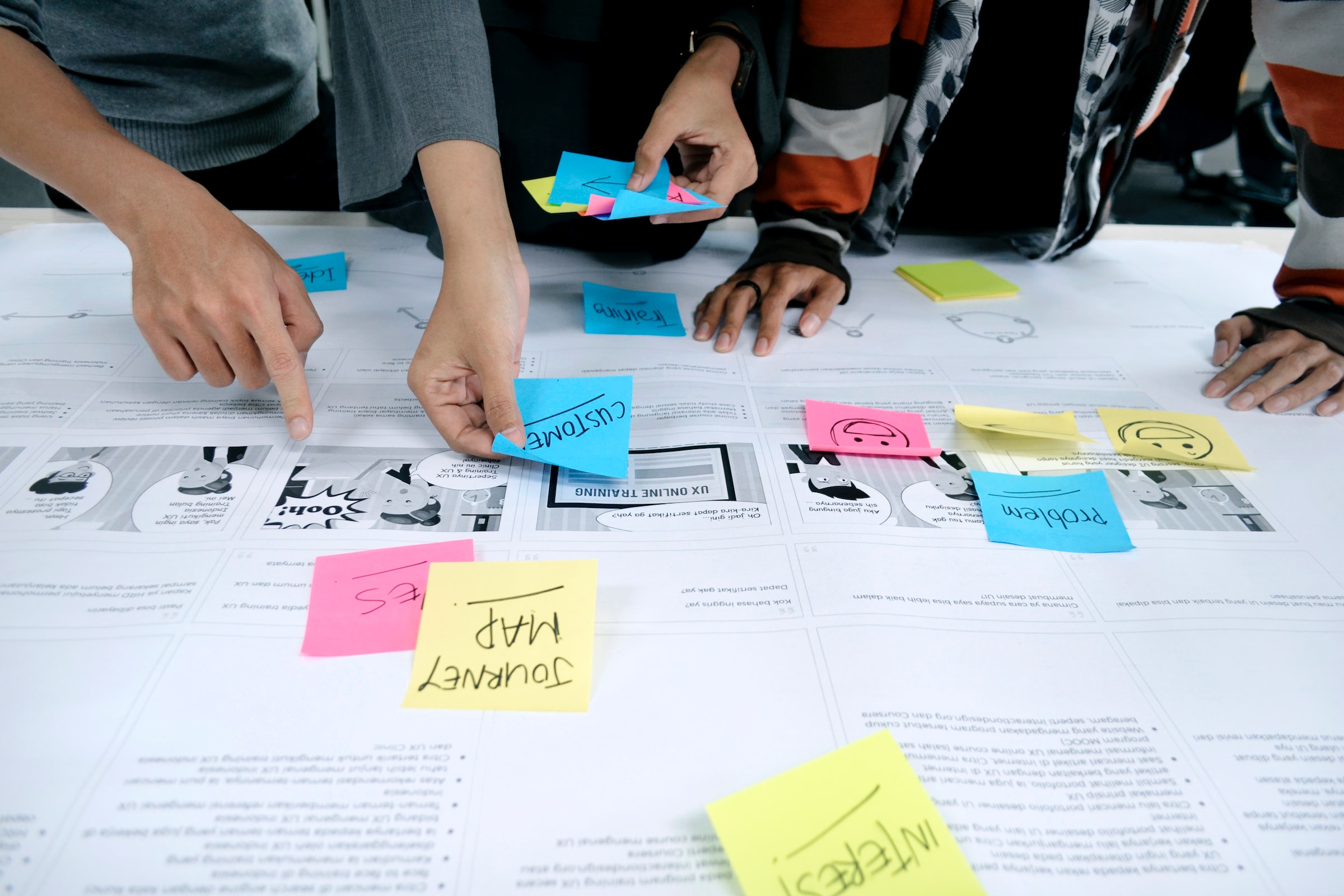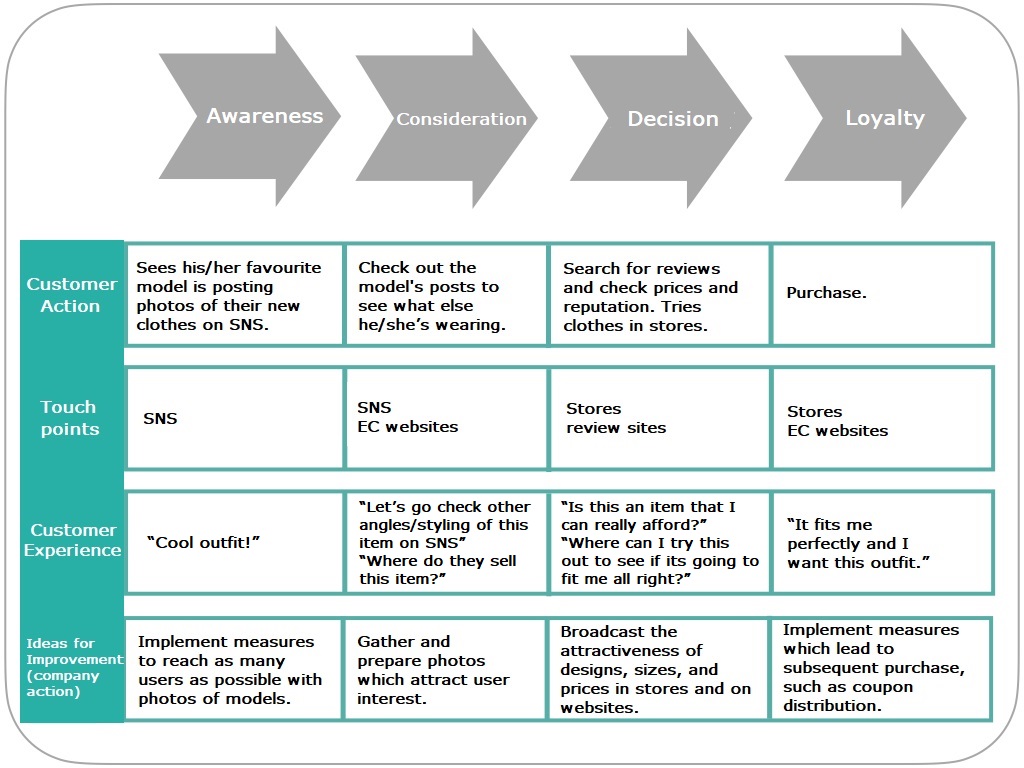Creating a Customer Journey Map:
6 Essential Steps
2022/11/17

Image by UX Indonesia on Unsplash
The Six Steps You Need To Create A Customer Journey Map
Customer journey maps are an important model for businesses to incorporate in order to better understand their target customers’ demographics. There are different approaches to take when preparing customer journey maps; particularly if the business operates on a B2B or B2C basis. It is recommended that when preparing a customer journey map, businesses should follow a number of steps, outlined below.
- Set a persona
- Clarify the goals of the customer journey map
- Set up a framework for the customer journey map
- Set customer behaviour at each stage, in chronological order
- Organise customer emotions and thoughts in each action phase
- Organise information along the frame
1. Setting a persona
A persona is a detailed description of your key customers, which offers an understanding of their feelings and behavioural patterns when interacting with the products or services you offer. Through this set persona, it will be easier for businesses to predict the customers’ patterns as they prepare their customer journey map.
The persona setting differs between B2B and B2C businesses, as the touchpoints between these two business models vary.
| B2B | B2C |
|---|---|
| Corporate persona + key person persona within the company |
Personal persona only |
For B2Bs, there are multiple personas to consider as the purchasing entity is an organisation, compared to B2Cs, where the purchaser is an individual. Therefore, it is important to set a persona for each person in charge at each stage of the B2B decision-making, such as recognition, examination, purchase and use.
As such, the methods of approach that B2Bs must adopt will change according to the persona at the touchpoint of each stage, as illustrated below.
| Approach partner | Approach method |
|---|---|
| A person who listens to the proposal summary by phone or at the office | Convey the appeal of your service over the phone in a concise manner and make it easy for the person in charge to take over. |
| A person who listens to specific proposals | Propose in a document the materials necessary for consideration, such as specific performance, price, support content, etc. |
| A person who explains the content of the proposal for internal approval | Compile materials that can prove specific cost-effectiveness and hand them to the person in charge of internal approval. |
B2B companies should also consider two additional patterns when setting the persona—the corporate persona and the key person persona. These would include factors listed below.
| Elements of corporate persona | Elements of in-house key person persona |
|---|---|
|
|
2. Set the goals of the customer journey map
It is important to be clear about your company’s goals and objectives when preparing the customer journey map, including the numbers your company aims to meet.
Example of goals set by companies include the following:
- Increasing the number of enquiries via the website in six months.
- Having XX-number of people purchase the new service/product for the first time within six months.
- Increase repeat customers of in-house services by XX% from the previous year.
3. Set up a framework
for the customer journey map
Creating a framework for the customer journey map that works for your company is important. While there are no specific rules on the framework, it is often created based on the following axes.
Horizontal axis: Process leading up to purchase and use, such as recognition and interest.
Vertical axis: The action, thought and touchpoints, etc. in each process stage (may include in-house actions).

4. Set customer behaviour at each stage
in chronological order
The actions of the personas are subdivided into goals that are set by the company, and then summarised in chronological order. In B2B, the behaviour is then further subdivided into the following eight stages:
| STEP | CUSTOMER BEHAVIOUR |
|---|---|
| Recognition of issues | Understand the business issues and think about introducing new services |
| Information gathering and product narrowing | Search the Internet and order materials |
| Product comparison/examination | Compare and consider performance and prices based on survey results |
| In-house review | Discuss and decide the products to be approved internally |
| In-house approval | Explain the products to be introduced to the authoriser |
| First introduction | Actual purchase |
| Evaluation of results by introduction | Judge the actual business improvement rate |
| Repeat | Determine if there is a repeat purchase based on the result of the first purchase |
In B2B, the person in charge during each touchpoint may change. Therefore, it is important to predict the behaviour accordingly for each touchpoint.
5. Organise customer emotions and thoughts
in each action phase
After defining the behaviour at each stage and clarifying the touchpoints, the emotions, thoughts, and concerns that customers may have are sorted out. This step is important because it shows that the company cares about its customers and good customer service leads to purchases/conversions/loyalty.
For example, if your company develops "software for customer management tools", the concerns that different personas may have in a company might be as follows:
- Sales representative: "It is difficult to update the sales progress of the customer".
- Accounting representative: "Management of invoices is difficult as too many invoices are issued".
- Decision-maker: "Introducing customer management tools will improve business performance".
As discussed above, the concerns and issues faced by employees and management within the company will be sorted. Once they are sorted, your company can then devise a strategy on how to solve them.
For B2C, analysing the following will help you organise your customers’ emotions.
- Consumer questionnaires
- Social media reviews
- Content of inquiries on the company's website
6. Organise information in the map
Once the emotions and concerns of each persona are identified they are incorporated in the customer journey map.
Points to note when creating
and operating a customer journey map
Keep the following points in mind when creating and operating the customer journey map.
| Precautions at the creation stage |
|
|---|---|
| Precautions at the operation stage | Continue refining after completing the customer journey map |
The customer journey map is an effective tool to learn about a customer’s perception of your company, products or service during each touchpoint. By learning about the perceptions and emotions the customer experiences from the awareness stage through to conversion, the company is able to devise better marketing strategies and come up with products and services that meet the needs of their customers, resulting in higher turnovers.
Beginner's Guide to Successful Online Survey
 |
Using online surveys is a quick and cost-effective way to understand your target consumer and build right strategies. |

